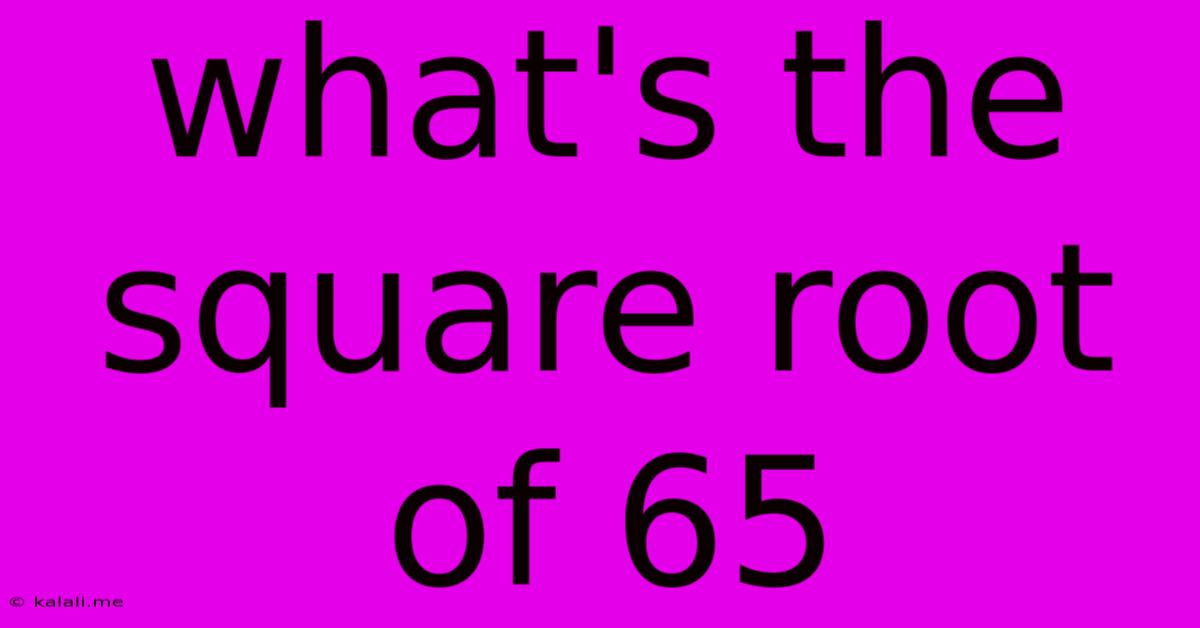What's The Square Root Of 65
Kalali
May 08, 2025 · 3 min read

Table of Contents
What's the Square Root of 65? A Deep Dive into Irrational Numbers
Finding the square root of 65 might seem like a simple math problem, but it opens a door to understanding a fascinating branch of mathematics: irrational numbers. This article will explore not only the numerical answer but also the concepts behind it, offering a comprehensive guide suitable for both students and curious minds.
The square root of a number is simply a value that, when multiplied by itself, equals the original number. For example, the square root of 9 is 3 because 3 x 3 = 9. However, unlike the square root of 9, the square root of 65 is not a whole number. It's an irrational number, meaning it cannot be expressed as a simple fraction and its decimal representation goes on forever without repeating.
Calculating the Square Root of 65
While you won't find a perfectly neat answer, we can approximate the square root of 65 using several methods:
-
Calculators: The easiest way is to use a calculator. You'll find that the square root of 65 is approximately 8.062257748. Keep in mind that this is just an approximation; the actual value extends infinitely.
-
Estimation: We know that 8² = 64 and 9² = 81. Since 65 lies between 64 and 81, the square root of 65 must be between 8 and 9. This gives us a rough estimate, useful for quick mental calculations.
-
Babylonian Method (or Heron's Method): This iterative method allows you to refine your approximation. Start with an initial guess (let's say 8), then apply the formula:
x_(n+1) = 0.5 * (x_n + (65/x_n)). Repeating this process will gradually get you closer to the actual value.
Understanding Irrational Numbers
The square root of 65 falls into the category of irrational numbers. These numbers are fundamentally different from rational numbers (which can be expressed as a fraction of two integers). Other famous examples of irrational numbers include π (pi) and e (Euler's number).
The key characteristic of irrational numbers is their non-repeating, non-terminating decimal representations. This means their decimal values continue infinitely without ever falling into a repeating pattern. This makes them impossible to represent precisely as a fraction.
Applications of Square Roots
Understanding square roots, even irrational ones like the square root of 65, has numerous applications in various fields:
-
Geometry: Calculating distances, areas, and volumes often involves square roots. Think of finding the diagonal of a rectangle or the hypotenuse of a right-angled triangle using the Pythagorean theorem.
-
Physics: Many physics formulas utilize square roots, particularly those dealing with motion, energy, and gravity.
-
Engineering: Square roots are crucial in various engineering calculations, including structural design and electrical circuits.
-
Computer Graphics: Square roots are essential for calculations involving 3D graphics and animations.
Conclusion
While the precise value of the square root of 65 remains elusive due to its irrational nature, understanding its approximation and the broader concepts of irrational numbers is invaluable. This knowledge provides a foundation for further exploration in mathematics and its diverse applications across various scientific and technological domains. From simple estimations to advanced iterative methods, there are many ways to approach this seemingly simple problem and uncover deeper mathematical principles.
Latest Posts
Latest Posts
-
How Does A Weighted Average Meter Measure Alternating Current
May 09, 2025
-
114 Cm In Inches And Feet
May 09, 2025
-
How Many Degrees Fahrenheit Is 80 Degrees Celsius
May 09, 2025
-
What Is 20 Off Of 90
May 09, 2025
-
What Is 0 66 As A Fraction
May 09, 2025
Related Post
Thank you for visiting our website which covers about What's The Square Root Of 65 . We hope the information provided has been useful to you. Feel free to contact us if you have any questions or need further assistance. See you next time and don't miss to bookmark.